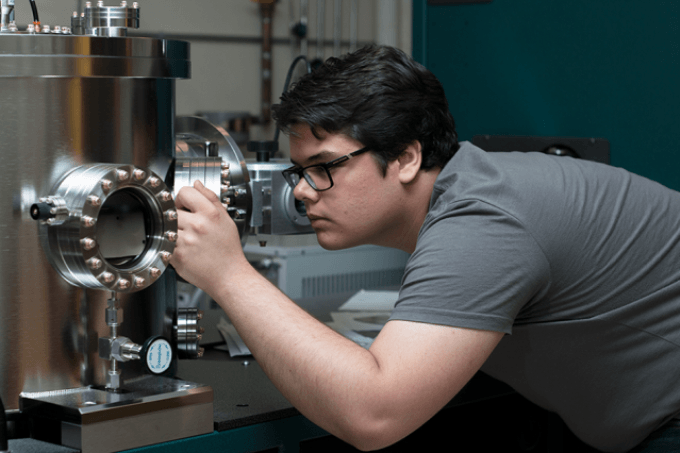Aug 17 2016
 Summer Scholar Grant Smith looks into a sputter deposition chamber, where he makes ultrathin films — from 2 to 10 nanometers thick — of magnetic materials suitable for spin-based electronics such as those used in computer memory systems. He is working under MIT assistant professor of electrical engineering and computer science Luqiao Liu. Smith’s summer project involves growing the films, making experimental device prototypes, and measuring their properties. (Photo Credit: Denis Paiste/Materials Processing Center)
Summer Scholar Grant Smith looks into a sputter deposition chamber, where he makes ultrathin films — from 2 to 10 nanometers thick — of magnetic materials suitable for spin-based electronics such as those used in computer memory systems. He is working under MIT assistant professor of electrical engineering and computer science Luqiao Liu. Smith’s summer project involves growing the films, making experimental device prototypes, and measuring their properties. (Photo Credit: Denis Paiste/Materials Processing Center)
MIT Materials Processing Center (MPC)-Center for Materials Science and Engineering (CMSE) Summer Scholar Grant Smith is working in Luqiao Liu’s lab to develop special thin film materials appropriate for spin-based devices that include magnetic tunnel junctions used in computer memory.
Luqiao Liu is an MIT assistant professor of electrical engineering and computer science.
Smith is operating a sputter deposition chamber for his summer project. He focuses on developing ultrathin films that have thickness of about 2 to 10 nanometers. Smith is designing devices that are precursors to a memory device and evaluating their properties.
Spin-based systems use magnetic tunnel junctions that are used for computer memory and these systems saw their initial breakthrough in 1994 by scientist Jagadeesh S. Moodera and colleagues at MIT. They are of great importance because they are capable of retaining information even when the power is off.
A magnetic tunnel junction combines together two thin film materials, and each thin film material has a unique property called ferromagnetism.
Those ferromagnetic layers can either have their magnetizations aligned or anti-aligned.
Grant Smith, MIT
The alignment of these materials results in the electrons in one layer containing more states for them in the other layer. However, if they are anti-aligned then there will be fewer states for electrons present in the other layer.
Change in Resistance
When you’re trying to push a current through and the magnetizations are aligned, the resistance is much lower. So if you fix one of the magnetic layers and flip the other one based on whether you want it to be a zero or a one or if you’re just trying to detect the existence of a magnetic field, you’ll be able to see something on the order of a 100 to 300 percent change in the resistance of that device.
Grant Smith, MIT
This is about 10 to 30 times higher than the approximate 10% shift in resistance in first such devices.
Smith is involved in working with a dual-layer of a ferromagnet known as cobalt iron boron and an antiferromagnet called iridium manganese. “Those two in conjunction, when you condition them in a specific way, they pin the magnetization of the one ferromagnet in that one specific direction. So that is your fixed layer,” he explains.
Smith is planning to establish the ability to develop these magnetic tunnel junctions in Liu’s laboratory for his summer project and if that succeeds, he plans to manipulate the magnetization with a topological semimetal’s spin texture in order to perform the switching process.
Nice Spot to be
“I’m just happy to learn anything about this field basically,” states Smith, a rising senior at Penn State University majoring in physics, who aims to pursue a doctorate in the sciences. “I’m glad to be learning how to manufacture these magnetic tunnel junctions. That’s a really important skill. They’re used everywhere as far as doing experiments in this field. They’re useful in industry. It’s actually a very nice spot to be in.”
So far I have been very glad with Grant Smith's performance. Having a summer intern working in our lab does provide a good advantage to our research as it allows us to look into directions that we were not able to previously due to a shortage of manpower. Moreover, Mr. Smith is really diligent and smart. It is a very nice experience so far to work with such a motivated undergraduate student.
Luqiau Liu, MIT
Working on materials at room temperature in Liu’s lab was a change of pace for Smith because at Penn state he had to work on materials at extremely low temperatures ranging 4K which is -452.47°F. “When you’re working with these sort of things you can learn about new behaviors, new scientific phenomenon,” he says. “Here everything is very room temperature focused working much closer towards, working much more closely with the place industry is at right now,” Smith says.
The nine-week National Science Foundation (NSF) Research Experience for Undergraduates internships was sponsored by CMSE and MPC with aid from NSF’s Materials Research Science and Engineering Centers program.